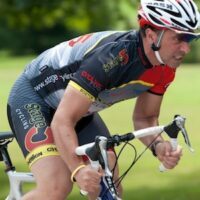In cycling we are surrounded by images of riders suffering as they go beyond their limits on steep mountain grades, vicious attacks, grueling time trials, and hair-raising sprints. The cycling and training world is filled with terms such as “the pain cave,” the “hurt box,” and the “sufferfest” to describe training sessions that prepare you physically and mentally to push yourself beyond your limits.
Should these verbal descriptions be a part of your coaching lexicon? You don’t want to sugarcoat it, because it is no secret that cycling and training can be hard. In fact, it can be very hard. But keep in mind that not everyone is in this for the same reasons. They may never care to enter the “hurt box.”
Nevertheless, whether their goal is increasing performance or losing weight, there is going to be some level of physical discomfort in an indoor cycling class due to intensity. It’s important for you to teach your riders the difference between the types of pain that require easing up, and pain the demands stopping what they are doing. The latter kind of physical pain would be the result of an injury or an impending injury if they don’t back off or stop (such as in the knee joint or back) or cardiovascular pain that is induced by pushing beyond their own physical fitness limits. The latter is certainly a huge liability.
But then there is the kind of suffering that won’t physically hurt them, but will in fact help them reach their goals if they can learn to endure it. This type of suffering requires mental fortitude to overcome. Two examples are the pain of being at your highest sustainable limit (a lactate threshold effort) and metabolic pain that is a result of high-intensity anaerobic efforts above the lactate threshold, resulting in the muscles being awash in an acidic environment as a result of going all out.
You should know your audience well and tailor your cues accordingly. If you are working with eager, motivated athletic students who are there to be driven beyond their comfort zones, then by all means, give them what they want and call a spade a spade!
On the other hand, temper your aggressive talk of how much pain they’re going to experience in your class if your market consists of a higher number of less fit, elderly, or overweight students and/or if your students have no desire for anything more than general fitness. But even in those cases, you will still want to inspire them to go beyond their own comfort zones, otherwise, they will not realize the success they desire. Using too many euphemisms to describe suffering or avoiding the idea of painful work will only make them distrust you, because their own definition of that kind of discomfort will be that what they are experiencing is “painful.”
If you have a mixed bag of students, then make sure to qualify your descriptions of the amount of suffering they should be aiming for in the high-intensity efforts. Remind them the difference between pain that should not be ignored (joints, chest pain) and discomfort that can be endured. And always, always give them the option of opting out. (In fact, you should always give those kinds of options, even to your very fit students, because they may need to be reminded that sometimes they need to back off.)
In this audio, Tom and I have an unstructured discussion on this topic of coaching very hard classes and your choice of verbiage. I think you are going to enjoy it!
As we were in the middle of this discussion, we decided that we will put together a list of our favorite cues that we use when we do indeed want to push our students to the point of discomfort/pain. In our discussion we also talk about how music can move us to push harder than we might otherwise push, and as an indoor cycling coach, your artful selection of motivating music can encourage the higher-intensity efforts you are asking for. Both Tom and I have a few songs that we turn to for those moments when suffering is our goal. I’ll post those shortly!
And coming soon, another discussion on the subject of pain and suffering, but this time it will be more on the mental side of coping with suffering in an interview with Dr. Haley Perlus.

